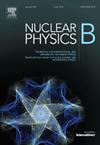Constructing noncommutative black holes
IF 2.5
3区 物理与天体物理
Q2 PHYSICS, PARTICLES & FIELDS
引用次数: 0
Abstract
We present a self-contained and consistent formulation of noncommutative (NC) gauge theory of gravity, focusing on spherically symmetric black hole geometries. Our construction starts from the gauge-theoretic viewpoint of Poincaré (or de Sitter) gravity and introduces noncommutativity through the Moyal star product and the Seiberg-Witten map, retaining NC gauge invariance at each order in the deformation parameter Θ. Working systematically to second order in Θ, we obtain explicit NC corrections to the spin connection, the vierbein, and various geometric objects such as the metric and curvature scalars. Using these results, we compute NC modifications of four-dimensional Schwarzschild and Reissner-Nordström solutions, including scenarios with a cosmological constant, as well as three-dimensional BTZ-type black holes (both uncharged and charged). For each black hole solution, we explore various possible Moyal twists, each of which generally breaks some symmetries and modifies the horizon structure, surface gravity, and curvature invariants. In particular, we show that while the radial location of horizons in Schwarzschild-like solutions remains unchanged for some twists, other twists introduce important but finite deformations in curvature scalars and can decouple the Killing horizon from the causal horizon. Similar patterns arise in the charged and lower-dimensional cases. Beyond constructing explicit examples, our approach provides a blueprint for systematically incorporating short-distance quantum corrections through noncommutativity in gravitational settings. The methods and expansions we present can be extended to more general geometries including rotating black holes and additional matter fields, offering a broad framework for future studies of NC effects in classical solutions of general relativity.
构造非交换黑洞
我们提出了一个自包含的和一致的非交换规范理论的重力,重点是球对称黑洞几何。我们的构造从poincar(或de Sitter)引力的量规理论观点出发,通过Moyal星积和Seiberg-Witten映射引入非交换性,在变形参数Θ的每个阶上保持NC量规不变性。在Θ系统地工作到二阶,我们获得了对自旋连接、维耶拜因和各种几何对象(如度量和曲率标量)的显式NC修正。利用这些结果,我们计算了四维史瓦西解和Reissner-Nordström解的NC修正,包括具有宇宙常数的场景,以及三维btz型黑洞(不带电和带电)。对于每个黑洞解,我们探索了各种可能的Moyal扭曲,每种扭曲通常都会打破一些对称性并修改视界结构,表面重力和曲率不变量。特别地,我们证明了虽然类史瓦西解中视界的径向位置对于某些扭曲保持不变,但其他扭曲在曲率标量中引入了重要但有限的变形,并且可以将杀伤视界与因果视界解耦。在带电和低维情况下也出现了类似的模式。除了构建明确的例子之外,我们的方法还提供了一个蓝图,可以通过引力设置中的非交换性系统地结合短距离量子修正。我们提出的方法和展开可以扩展到更一般的几何,包括旋转黑洞和额外的物质场,为未来研究广义相对论经典解中的NC效应提供了一个广泛的框架。
本文章由计算机程序翻译,如有差异,请以英文原文为准。
求助全文
约1分钟内获得全文
求助全文
来源期刊

Nuclear Physics B
物理-物理:粒子与场物理
CiteScore
5.50
自引率
7.10%
发文量
302
审稿时长
1 months
期刊介绍:
Nuclear Physics B focuses on the domain of high energy physics, quantum field theory, statistical systems, and mathematical physics, and includes four main sections: high energy physics - phenomenology, high energy physics - theory, high energy physics - experiment, and quantum field theory, statistical systems, and mathematical physics. The emphasis is on original research papers (Frontiers Articles or Full Length Articles), but Review Articles are also welcome.
 求助内容:
求助内容: 应助结果提醒方式:
应助结果提醒方式:


